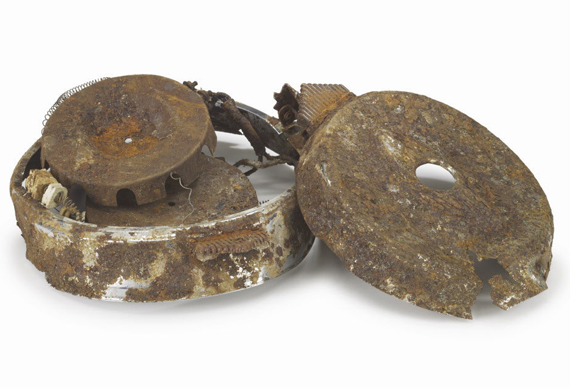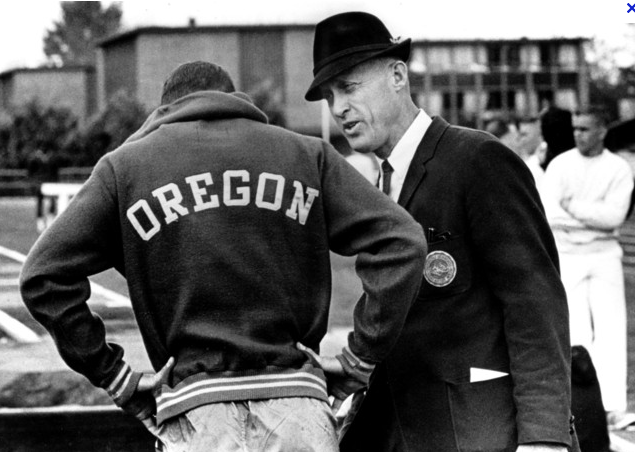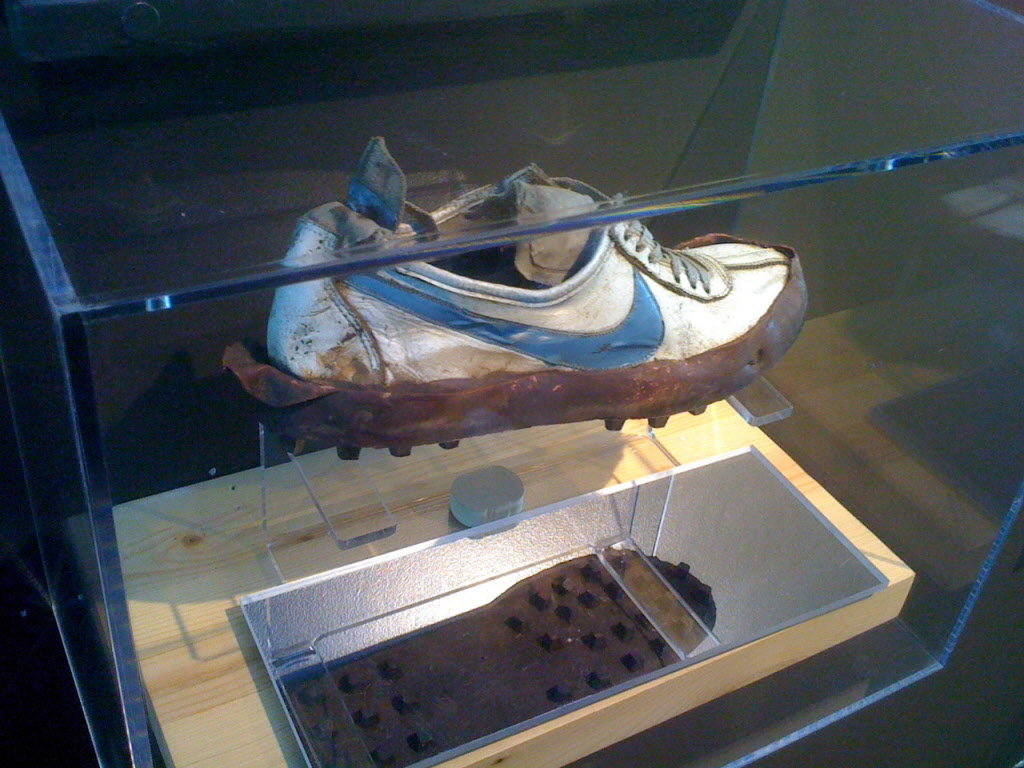The following is excerpted from the chapter, “The Running Shoe” in the new book, Tread Lightly: Form, Footwear, and the Quest for Injury-Free Running, by Peter Larson and Bill Katovsky — NRC

***
Man spent several million years evolving as a runner. The athletic shoe has a much shorter history—about 180 years. But the modern running shoe is even younger, a mere adolescent who came of age during the early era of space exploration. The timing probably explains why Nike’s original waffle-tread shoes that market-launched in the early 70s became widely known as “moon shoes.” The distinctive grid-like pattern that the soles made in dirt resembled the footprints left behind by the American astronauts on the lifeless, chalky lunar soil. Those NASA tread marks are still visible on the moon—untouched and undisturbed on the windless landscape. Yet here on our own planet, the evidence of where and how man first went shod is more difficult to nail down with any certainty. It’s a guessing game with science helping when it can.
In 1938, Luther Cressman, an Oregon-based anthropologist who was once briefly married to Margaret Mead, unearthed a pair of well-preserved, shredded sagebrush bark sandals from an upraised volcanic landmass, also called a tuff ring, near Fort Rock, Oregon. These shoes were radiocarbon-dated to be around 10,000 years old, making them the oldest footwear ever discovered. Cressman ended up finding dozens of sandals buried beneath a hardened layer of volcanic ash that resulted from the eruption of the Mt. Mazama volcano 7,500 years ago. It was an amazing footwear fossil trove, but there is another coincidental item regarding this discovery that occasionally surfaces in books and articles about Nike’s storied past. The University of Oregon’s legendary track coach and co-founder of Nike, Bill Bowerman, who had created the original waffle trainer, was born in Fossil, Oregon, which is located about 150 miles north of the archeological site.

Bowerman’s son, Jon, now in his early seventies and a former U.S. Olympic ski coach, still lives in Fossil on the family ranch that once bordered the infamous, scandal-plagued Bhagwan Rajneesh commune. In 2010, an important relic was found in a rubbish-filled landfill on the Bowerman ranch. Jon’s brother accidentally came across the very same waffle iron that was used by his father to create a new urethane running sole. The iron was corroded, rusted, and clearly unusable. Reached at his home in Fossil in December 2010, Jon Bowerman recalled that simple cooking gadget. “The chrome waffle iron had been in our family for a long time, since about 1936. It was either a wedding gift, or bought around the same time. It was small, so you could only make one waffle at a time. Which meant, Dad had to cook the rubber twice to make two soles. He then glued both soles to nylon uppers to make the final shoes.” Understandably, a whole lot of mythology has burnished this simple cooking appliance that should have its own display case in the Smithsonian, even though its closer-to-home final resting place is Nike’s corporate headquarters in Beaverton, Oregon. The waffle iron actually belonged to Bill’s wife. Years before oxidizing rust set in, the cooked, blackened rubber forever ruined the gadget.
But what else do we know about the Bowerman waffle-iron legacy? Two smartly written books, Swoosh, by J. B. Strasser and Laurie Becklund, and Bill Bowerman and the Men of Oregon, by Kenny Moore, make for fascinating reading about Bowerman and Nike’s early history. Bowerman was a born tinkerer, blessed with the DNA of a restless, curious mind, and coauthor of a 126-page national bestselling book called Jogging that came out in the late 1960s. As the long-time track coach at the University of Oregon, his résumé is remarkable: four National Collegiate Athletic Association track and field championships; in addition, he coached forty-four all-Americans and nineteen Olympic athletes. When he was away from the track, Bowerman constantly experimented with ways to remove nonessential ounces from running shoes in order to improve their performance. He said that the “ideal shoe would provide enough support for a runner during a race, but would fall apart once that runner crossed the finish line.” He tried out new designs and materials for the soles, spikes and uppers.
In a 1960 Sports Illustrated profile of Bowerman, he was quoted as saying, “‘The ordinary track shoe is covered with junk. Leather trim, tongue, laces. All unnecessary.’ {The Bowerman} shoe, which he cuts and sews himself to fit the athlete, is a combination of scraps of leather, elastic and canvas which weighs only about four ounces, as against 6½ ounces for the ordinary shoe. Bowerman figures that if he cuts the weight of the shoe an ounce, he’s saving the runner from lifting approximately 200 pounds in a mile race, depending upon the runner’s stride.”

Bowerman’s collegiate runners were accustomed to his restless nature, unorthodox manner and tough love. One of those track men was an above-average middle-distance runner named Phil Knight, whose personal best for the mile was 4:10. After acquiring an MBA from Stanford, where he wrote a seminal paper, “Can Japanese Sports Shoes Do to German Sports Shoes What Japanese Cameras Did to German Cameras?” Knight traveled to Japan, where he was able to secure distribution rights to sell Onitsuka Tiger running shoes in the United States. He then entered into a handshake agreement with his former coach in 1964 to create Blue Ribbon Sports. While Knight kept his day job as an accountant, their fledgling startup—which was going up against German footwear giants Puma and adidas—sold 300 pairs of these inexpensive flat-soled sneakers in their first year, mainly to high school and college runners in the Pacific Northwest, often by showing up at track meets with a car trunk full of Tigers.
Revenue at Blue Ribbon Sports grew each year, fueled in part by a small sales team of passionate runners. Meanwhile, Bowerman’s design ideas led to the creation of a new Tiger running shoe called the Cortez, which had a rippled rubber sole for traction and a dual-density foam wedge for additional cushioning support and shock absorption. The inclusion of a slight heel-raising wedge resulted from Bowerman’s belief that it would help coax a runner forward and reduce the strain placed on the Achilles tendon. (Little did he or anyone know at the time that this small wedge would one day take on a massively metastasizing life all of its own and influence running shoe design for years to come.) The distinctive Tiger stripes on the sides, which first appeared on the Mexico 66 models, were there to provide midfoot reinforcement. The Cortez was released right after the 1968 Mexico Olympics. Despite going up against both Adidas and Puma and their well-entrenched sales and promotional machines, the Cortez quickly became a top-seller running sneaker in the U.S. due to Blue Ribbon’s more aggressive grassroots marketing.
Phil Knight parted ways with Onitsuka and Tiger in 1971, a decision that was ultimately rooted in mutual distrust over sales territory and distribution rights. This divorce led to several years of a fiercely contested legal battle; but during this period, Knight’s new company (later renamed Nike) was busy selling a somewhat similarly designed shoe, which was also called Cortez but made with lightweight nylon uppers and a suede toebox. (It debuted in early 1972). Following a 1974 U.S. district court judgment that was based on trademark infringement, Tiger was forced to change the shoe name to Corsair and pay Blue Ribbon monetary damages. Knight’s swashbuckling crew in Oregon kept the Cortez name.
The Cortez is one of Nike’s most iconic footwear models—and not just with runners. (It’s the shoe Forrest Gump wore during his transcontinental crossings.) Retro models can be easily purchased online. It has street cred with Southern California gang members who probably feel like they are always running from the cops. In 2008, Lil Rob, a popular Mexican-American music producer and rapper, wrote a hit song called “Cortez shoes,” whose lyrics include these lines: “These Cortez shoes know all the hard times that we had been through. All the crazy things we used to do just to get by walk in my shoes and you . . .”

First the wedge, then the waffle-sole. Each was born from Bowerman’s fertile imagination, and together, they were largely responsible for Nike’s success as a young athletic footwear company. As a descendant of pioneers who had come west on the Oregon Trail in the 1840s, Bowerman had his own eureka moment in 1971. Seeking a more ground-efficient sole that could replace common track spikes, Bowerman poured a gooey, rubber-like compound into his wife’s waffle iron. He then cooked the non-edible batter. The process took several attempts to get the urethane concoction just right, by which time the waffle iron became, well, toast. But the end result was an inverse-outsole waffle-pattern of nubby spikes.
Geoff Hollister, another trackman who had run for Oregon, who was Nike’s third employee, was the first person to try out the new waffle-tread shoes (Hollister would drive to local races and sell Tigers to coaches and athletes from the trunk of his car, earning a $2 commission on each pair purchased.) “When Geoff Hollister slipped on Bill’s first test pair,” writes Kenny Moore, “he found that the ‘urethene spikes’ on the balls of his feet seemed to grip almost regardless of what they touched, be it track, road, grass, or mud. In the fall, Bowerman made me a pair . . . and I too felt that they had broader applications than just the track. I was so sure they were going to let me run away from Frank Shorter in the 1971 AAU cross-country race in San Diego that I got excited and ran the first mile in 4:19.” Shorter went 4:30 each and every mile and won, while a dialed-back Moore placed sixth. But Moore became a complete convert to waffle-tread running shoes, and later ran a 4:03.2 in them, “thought to be the fastest mile in a flat at that time.”
 The rubber studs of the waffle sole offered a forgiving springiness that was welcomed not only by world-class athletes, but also by everyday runners. The shoes, as Time magazine then wrote, were ‘’grabbed by the army of weekend jocks suffering from bruised feet.’’ And it was the waffle trainer that placed Nike on the global athletic footwear map, giving adidas and Puma a serious run for the money—and set the stage for its unparalleled growth. Today, Nike is a publicly traded multi-billion dollar behemoth with a vast array of shoes, apparel, and products for almost all the major sports. Its Swoosh logo, created for the princely sum of $35 by a young graphic designer by the name of Carolyn Davidson, has become one of the world’s most recognizable symbols. (The original Swoosh went straight across the Nike letters, making it hard to read; people often mistakenly called the shoes “Mike.”)
The rubber studs of the waffle sole offered a forgiving springiness that was welcomed not only by world-class athletes, but also by everyday runners. The shoes, as Time magazine then wrote, were ‘’grabbed by the army of weekend jocks suffering from bruised feet.’’ And it was the waffle trainer that placed Nike on the global athletic footwear map, giving adidas and Puma a serious run for the money—and set the stage for its unparalleled growth. Today, Nike is a publicly traded multi-billion dollar behemoth with a vast array of shoes, apparel, and products for almost all the major sports. Its Swoosh logo, created for the princely sum of $35 by a young graphic designer by the name of Carolyn Davidson, has become one of the world’s most recognizable symbols. (The original Swoosh went straight across the Nike letters, making it hard to read; people often mistakenly called the shoes “Mike.”)
***
Excerpted from the new book, Tread Lightly: Form, Footwear, and the Quest for Injury-Free Running

Prefontaine was one of the best distant runners ever, and if he wouldn’t died at a early age would have beaten the swede who beat him in Germany.I wore a pair of Nike Waffles when I ran back in high school 1982, best shoes around for the mile and two mile, very light and comfortable.
Oh, I seen without limits about 100,000 times, big fan of the waffle iron, and Bowermans coaching, and Prefontains running methods and racing.
you mean Lasse Viren from Finland?
Yes he means Lasse Viren lol forgive his ignorance. But he’s right if Pre didn’t die when he did he would’ve beaten Viren in Montreal and possibly win again in 1980. Pre, while he had been running at an elite level since his junior year of high school when he ran 14:12 in the 5000m, he was just reaching his prime. In ’74 he ran a 3:58 indoor mile. He ran consistently sub-13:20 in the 5000m thru ’74 & ’75 until his death. It was only a matter of time for him to take the world record and beat Viren. But he never got the chance. I may be going out of my way by saying this, but I picture’d Pre as being the first sub-13:00 5000m. Now there’s no telling if he could’ve accomished that. Oh well. RIP Steve Prefontaine.
Prefontaine was/is Jared Leto. Jared Leto has not aged since he was born in 30 A.D., hence 30 seconds to mars. Jared Leto aka Prefontaine is from mars, an immortal being that had to fake his own death after his loss to Viren to preserve his species dignity and superiority. He re-emerged in the late 90’s and early 2000’s as a ultra talented musician and movie star, thus playing Steve Prefontaine in the movie, “Prefontaine” to tell the real, (fake) story of his fake death.
interesting….
how much did this shoe cost?
about the price of a burger and beer I think. mine were 20 bucks
Wow! This was really interesting. I can’t imagine living without footwear and yet it appears our ancestors did for most of our species existence. That picture of the 10,000-year-old footwear is just amazing. We’re so lucky to be able to look back in time.
Keep up the great work you are doing, I’m a big fan of your blog 🙂
Take care and stay safe
Jane